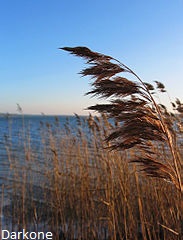Ecological Importance
Invasive phragmites provides some erosion control protection and habitat for wildlife. However, due to its invasive nature and negative impacts to native plants it should be eradicated where possible. |
 |
Problems
Invasive phragmites harms the environment by reducing wildlife habitats, decreasing plant diversity, and altering water levels by trapping sediments. In addition, invasive phragmites can be a fire hazard. Stands along roadsides can obstruct the view of drivers, leading to automobile accidents, and stands along shorelines can reduce property values by blocking lake views, and restricting access for swimming, fishing and hunting.
A native phragmites (Phragmites australis subsp. americanus) once grew abundantly in North America, but currently is rare because it has been displaced by invasive phragmites.
Plant Description:
Invasive phragmites plants grow up to 15 feet tall and form grayish-purple, feather-like flower heads in late July. These plumes are five to 16 inches long and develop dark brown seed heads at maturity. Invasive phragmites leaves have sheaths that are wrapped tightly around the stalk, and leaf blades that are rough-margined, flat, and linear in shape with a gray-green color. At the base of each leaf blade, a fringe of hairy ligules is present with no auricle clasping the stalk.
Hints to Identify
To distinguish native phragmites from invasive phragmites, closely observe the plant's stalk. Stalks of invasive phragmites plants are rigid, rough, dull, tan in color, and hollow inside. Native phragmites plants develop non-rigid, smooth, lustrous reddish-colored stalks during the growing season.
|
Homeowner Treatment Options
|
| Shoreline Defense |
| *Aquatic Biologists recommends implementing preventative management techniques and physical removal prior to, or in conjunction with treatment. |
Common Application Questions
Q. How much should I treat?
A. The entire population should be treated as phragmites is invasive.
Q. When is the best time to treat?
A. Once water temperatures are around sixty degrees or warmer.
Q. How often do I need to treat Phragmites?
A. Multiple treatments are generally required.
Q. How long before I see results?
A. It really depends on the product you choose. For most vegetation, control will take approximately 2 weeks however, tissue damage may be evident within 2 to 4 days with liquid formulations. Some products are slower acting with results taking 30 days or more to achieve.
